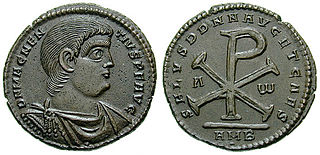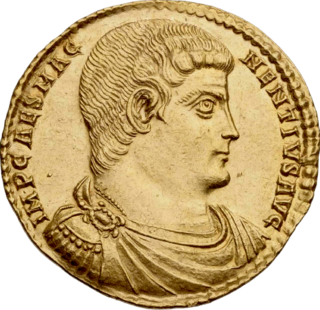
Constantius II was Roman emperor from 337 to 361. His reign saw constant warfare on the borders against the Sasanian Empire and Germanic peoples, while internally the Roman Empire went through repeated civil wars, court intrigues, and usurpations. His religious policies inflamed domestic conflicts that would continue after his death.

Year 251 (CCLI) was a common year starting on Wednesday of the Julian calendar. At the time, it was known as the Year of the Consulship of Traianus and Etruscus. The denomination 251 for this year has been used since the early medieval period, when the Anno Domini calendar era became the prevalent method in Europe for naming years.
The 350s decade ran from January 1, 350, to December 31, 359.
The 290s decade ran from January 1, 290, to December 31, 299.
The 250s was a decade that ran from January 1, 250, to December 31, 259.

Year 357 (CCCLVII) was a common year starting on Wednesday of the Julian calendar. At the time, it was known as the Year of the Consulship of Constantius and Iulianus. The denomination 357 for this year has been used since the early medieval period, when the Anno Domini calendar era became the prevalent method in Europe for naming years.

Year 354 (CCCLIV) was a common year starting on Saturday of the Julian calendar. At the time, it was known as the Year of the Consulship of Constantius and Constantius. The denomination 354 for this year has been used since the early medieval period, when the Anno Domini calendar era became the prevalent method in Europe for naming years.
Year 352 (CCCLII) was a leap year starting on Wednesday of the Julian calendar. At the time, it was known as the Year of the Consulship of Decentius and Paulus. The denomination 352 for this year has been used since the early medieval period, when the Anno Domini calendar era became the prevalent method in Europe for naming years.

Year 350 (CCCL) was a common year starting on Monday of the Julian calendar. At the time, it was known as the Year of the Consulship of Sergius and Nigrinianus. The denomination 350 for this year has been used since the early medieval period, when the Anno Domini calendar era became the prevalent method in Europe for naming years.

Valentinian I, sometimes called Valentinian the Great, was Roman emperor from 364 to 375. He ruled the Western half of the empire, while his brother Valens ruled the East. During his reign, he fought successfully against the Alamanni, Quadi, and Sarmatians, strengthening the border fortifications and conducting campaigns across the Rhine and Danube. His general Theodosius defeated a revolt in Africa and the Great Conspiracy, a coordinated assault on Roman Britain by Picts, Scoti, and Saxons. Valentinian founded the Valentinianic dynasty, with his sons Gratian and Valentinian II succeeding him in the western half of the empire.

Magnus Magnentius was a Roman general and usurper against Constantius II. Of Germanic descent, Magnentius served with distinction in Gaul under the emperor Constans. On 18 January 350 Magnentius was acclaimed Augustus. Quickly killing the unpopular Constans, Magnentius gained control over most of the Western Empire. The Eastern emperor Constantius II, the brother of Constans, refused to acknowledge Magnentius' legitimacy and led a successful campaign against Magnentius. Ultimately, Magnentius' forces were scattered after the Battle of Mons Seleucus, and he committed suicide on 10 August 353.

Zhao, briefly known officially as Wei (衛) in 350, known in historiography as the Later Zhao or Shi Zhao (石趙), was a dynasty of China ruled by the Shi family of Jie ethnicity during the Sixteen Kingdoms period. According to Alexander Vovin, the Jie were most likely a Yeniseian people and spoke next to Chinese one of the Yeniseian languages. Among the Sixteen Kingdoms, the Later Zhao was the second in territorial size to the Former Qin dynasty that once unified northern China under Fu Jian.

Flavius Claudius Constantius Gallus (326–354) was a statesman and ruler in the eastern provinces of the Roman Empire from 351 to 354, as Caesar under emperor Constantius II, his cousin. A grandson of emperor Constantius Chlorus and empress Flavia Maximiana Theodora, and a son of Julius Constantius and Galla, he belonged to the Constantinian dynasty. Born during the reign of his uncle Constantine the Great, he was among the few male members of the imperial family to survive the purge that followed Constantine's death. Under Constantius II, Gallus served as deputy emperor, based in Antioch and married to Constantius' sister Constantina. He dealt with a Jewish revolt in the years 351-352. Gallus ultimately fell out of favor with Constantius and was executed, being replaced as Caesar by his younger half-brother Julian.
Ran Min, also known as Shi Min (石閔), posthumously honored by the Former Yan as Heavenly King Wudao of (Ran) Wei ( 魏武悼天王), courtesy name Yongzeng (永曾), nickname Jinu (棘奴), was a military leader during the era of Sixteen Kingdoms in China and the only emperor of the short-lived state Ran Wei (冉魏). He was known for ordering the culling of the Jie and other barbarians, during which 200,000 people, both Han and non-Han people, were killed between 349 and 350.
The Battle of Mursa was fought on 28 September 351 between the eastern Roman armies led by the Emperor Constantius II and the western forces supporting the usurper Magnentius. It took place at Mursa, near the Via Militaris in the province of Pannonia. The battle, one of the bloodiest in Roman history, was a pyrrhic victory for Constantius.

Flavia Valeria Constantina, later known as Saint Constance, was the eldest daughter of Roman emperor Constantine the Great and his second wife Fausta, daughter of Emperor Maximian. Constantina may have received the title of Augusta from her father, and is venerated as a saint, having developed a medieval legend wildly at variance with what is known of her actual character.
Shi Zhi was the final emperor of the Jie-led Chinese Later Zhao dynasty. He was the last of four short-lived emperors after the death of his father Shi Hu. Shi Zhi reigned briefly for about a year. He is sometimes referred to by his title prior to becoming emperor, Prince of Xinxing (新興王).

Marcellinus was a Roman Empire officer under Roman Emperor Constans and usurper Magnentius.
The Ran Wei–Later Zhao War, or Wei–Zhao War, was a conflict in northern China in 350 CE, during the chaotic Sixteen Kingdoms period. In 350, Ran Min proclaimed himself emperor of Wei amid the succession struggles of the Later Zhao dynasty. The Jie people, who founded the Later Zhao, did not accept Ran Min's rule and rose against him; they were joined by many other dynasties established by the Five Barbarians that also opposed Ran Min. The resulting war ended with a decisive victory for Ran Min.

Wei, known as Ran Wei (冉魏) in Chinese historiography, was a short-lived dynastic state of China established by Ran Min. In 350, Ran Wei usurped the throne of the Later Zhao dynasty in the city of Ye and declared himself Emperor of Wei. In 352, Ran Wei was defeated by the Former Yan dynasty.











